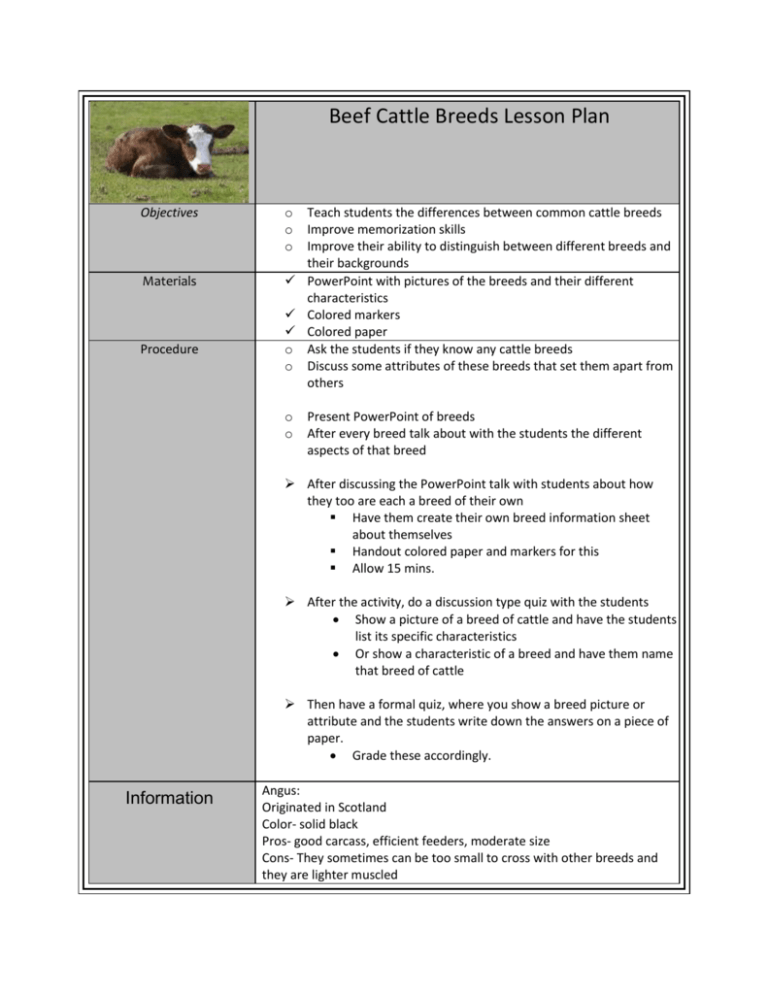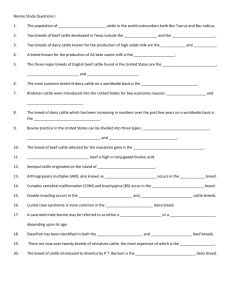Beef Cattle Breeds Lesson Plan With Microsoft Word
advertisement

Beef Cattle Breeds Lesson Plan Objectives Materials Procedure o o o Teach students the differences between common cattle breeds Improve memorization skills Improve their ability to distinguish between different breeds and their backgrounds PowerPoint with pictures of the breeds and their different characteristics Colored markers Colored paper o Ask the students if they know any cattle breeds o Discuss some attributes of these breeds that set them apart from others o o Present PowerPoint of breeds After every breed talk about with the students the different aspects of that breed After discussing the PowerPoint talk with students about how they too are each a breed of their own Have them create their own breed information sheet about themselves Handout colored paper and markers for this Allow 15 mins. After the activity, do a discussion type quiz with the students Show a picture of a breed of cattle and have the students list its specific characteristics Or show a characteristic of a breed and have them name that breed of cattle Then have a formal quiz, where you show a breed picture or attribute and the students write down the answers on a piece of paper. Grade these accordingly. Information Angus: Originated in Scotland Color- solid black Pros- good carcass, efficient feeders, moderate size Cons- They sometimes can be too small to cross with other breeds and they are lighter muscled Size: Cows- 1200 lbs Bulls- 1800 lbs Official Name: Aberdeen Angus Charolais Originated in France Color- White, but there is a variation in shades of white Pros: heavy muscled and they adapt well to most areas Cons: high feed efficiency ratio and they are typically horned Size: Cows- 1500lbs Bulls- 2200lbs Chianina (pronunciation: key-a-nee-na) Origin: Italy Color: (purebred) White, Black and Red, with or without white Pros: very useable in crossbred programs, no color standards in their association, and good mothers Cons: size, color, and type vary a lot and aren’t consistent Size (purebred): up to... Cows: 2400lbs Bulls: 4000lbs Hereford Origin: England Color: shades of red with white Pros: docile, efficient feeders, hardy, and easily crossed up Cons: horned, and their typical white color pattern is dominant and hard to breed out Size: Cows: 1200 lbs Bulls: 1800 lbs Polled Hereford Origin- Iowa Color- same as horned Hereford Pros: no horns Cons: Slightly less muscled. Limousin Origin: France Color: light yellow to dark red, brown, and black Pros: heavy muscled, lean carcass, and large loins Cons: they are hard to cross with and they can be horned Size: Cows: 1400 lbs Bulls: 2200 lbs Maine-Anjou Origin: France Color: red and black, with or without white Pros: they are great breed producers, they are also docile and crossable Cons: they can be horned and their coloring isn’t consistent Size: Cows 1500lbs Bulls 2500lbs Shorthorn Origin: England Color: red, white, and a mixture of red and white known as roan Pros: they are docile, crossable with mostly anything, very adaptable, and good carcass and mothers. Cons: can be horned Size: Cows 1500lbs Bulls 2400lbs Simmental Origin: Switzerland Color: black, red, brown, tan, yellow, all with or without white Pros: fast growers, heavy muscled, and they adapt well to any climate Cons: horned, can be too big and their coloring is inconsistent Size Cows 1800lbs Bulls 2600lbs Brahman Origin: Southwest U.S. Color: light gray to red to black, the most common color is light to medium gray Pros: Crossed to create new breeds in the U.S, they are heat, insect, and disease tolerant, and they are good mothers Cons: unpredictable dispositions Size: Cows 1200lbs Bulls 2000lbs Santa Gertrudis Origin: King Ranch in Texas Color: cherry red Pros: efficient feeders, little waste of fat, disease and insect resistant Cons: lots of extra skin and they are horned The size of bulls and cows varies. Activity After presenting the PowerPoint talk with the students about what distinguishes them as who they are. Examples are hair color, eye color, where they live, what they do and don’t like to do. Then show the connection between breed characteristics and personality, they are each like a different breed. Then have the students make their own “breed” information sheet about themselves. Handout markers and colored paper for them to use Make sure they know to include: • Name • Origin • Hair and Eye color • Pros • Cons • Size • Official Name Assessment Give 15 mins for this Do a discussion type quiz: 1. Show a picture of a breed of cattle 2. Have the students name off different attributes of that breed 3. Show a characteristic of a breed 4. Have the students name that breed and then more characteristics Finally, do a formal quiz: 1. Have the students get out paper and pencil and explain that this is by yourself 2. Repeat steps 1-4 in discussion quiz Credit Grade quizzes on accuracy of answers “Ideas-4-Ag-Ed” http://www.ideas4ag-ed.com/animal-science--livestockmanagement.html Amanda_mullins_beef_cattle_breeds_ppt






